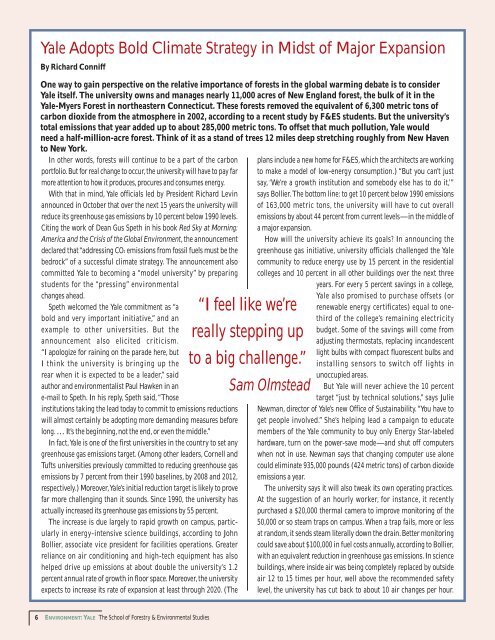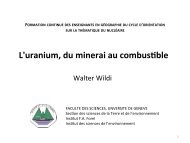As a Remedy to Global Warming, As a Remedy to Global Warming
As a Remedy to Global Warming, As a Remedy to Global Warming
As a Remedy to Global Warming, As a Remedy to Global Warming
Create successful ePaper yourself
Turn your PDF publications into a flip-book with our unique Google optimized e-Paper software.
Yale Adopts Bold Climate Strategy in Midst of Major ExpansionBy Richard ConniffOne way <strong>to</strong> gain perspective on the relative importance of forests in the global warming debate is <strong>to</strong> considerYale itself. The university owns and manages nearly 11,000 acres of New England forest, the bulk of it in theYale-Myers Forest in northeastern Connecticut. These forests removed the equivalent of 6,300 metric <strong>to</strong>ns ofcarbon dioxide from the atmosphere in 2002, according <strong>to</strong> a recent study by F&ES students. But the university’s<strong>to</strong>tal emissions that year added up <strong>to</strong> about 285,000 metric <strong>to</strong>ns. To offset that much pollution, Yale wouldneed a half-million-acre forest. Think of it as a stand of trees 12 miles deep stretching roughly from New Haven<strong>to</strong> New York.In other words, forests will continue <strong>to</strong> be a part of the carbonportfolio. But for real change <strong>to</strong> occur, the university will have <strong>to</strong> pay farmore attention <strong>to</strong> how it produces, procures and consumes energy.With that in mind, Yale officials led by President Richard Levinannounced in Oc<strong>to</strong>ber that over the next 15 years the university willreduce its greenhouse gas emissions by 10 percent below 1990 levels.Citing the work of Dean Gus Speth in his book Red Sky at Morning:America and the Crisis of the <strong>Global</strong> Environment, the announcementdeclared that “addressing CO2 emissions from fossil fuels must be thebedrock” of a successful climate strategy. The announcement alsocommitted Yale <strong>to</strong> becoming a “model university” by preparingstudents for the “pressing” environmentalchanges ahead.Speth welcomed the Yale commitment as “abold and very important initiative,” and anexample <strong>to</strong> other universities. But theannouncement also elicited criticism.“I apologize for raining on the parade here, butI think the university is bringing up therear when it is expected <strong>to</strong> be a leader,” saidauthor and environmentalist Paul Hawken in ane-mail <strong>to</strong> Speth. In his reply, Speth said, “Thoseinstitutions taking the lead <strong>to</strong>day <strong>to</strong> commit <strong>to</strong> emissions reductionswill almost certainly be adopting more demanding measures beforelong. … It’s the beginning, not the end, or even the middle.”In fact,Yale is one of the first universities in the country <strong>to</strong> set anygreenhouse gas emissions target. (Among other leaders, Cornell andTufts universities previously committed <strong>to</strong> reducing greenhouse gasemissions by 7 percent from their 1990 baselines, by 2008 and 2012,respectively.) Moreover,Yale’s initial reduction target is likely <strong>to</strong> provefar more challenging than it sounds. Since 1990, the university hasactually increased its greenhouse gas emissions by 55 percent.The increase is due largely <strong>to</strong> rapid growth on campus, particularlyin energy-intensive science buildings, according <strong>to</strong> JohnBollier, associate vice president for facilities operations. Greaterreliance on air conditioning and high-tech equipment has alsohelped drive up emissions at about double the university’s 1.2percent annual rate of growth in floor space. Moreover, the universityexpects <strong>to</strong> increase its rate of expansion at least through 2020. (The“I feel like we’rereally stepping up<strong>to</strong> a big challenge.”plans include a new home for F&ES, which the architects are working<strong>to</strong> make a model of low-energy consumption.) “But you can’t justsay, ‘We’re a growth institution and somebody else has <strong>to</strong> do it,’”says Bollier. The bot<strong>to</strong>m line: <strong>to</strong> get 10 percent below 1990 emissionsof 163,000 metric <strong>to</strong>ns, the university will have <strong>to</strong> cut overallemissions by about 44 percent from current levels—in the middle ofa major expansion.How will the university achieve its goals? In announcing thegreenhouse gas initiative, university officials challenged the Yalecommunity <strong>to</strong> reduce energy use by 15 percent in the residentialcolleges and 10 percent in all other buildings over the next threeyears. For every 5 percent savings in a college,Yale also promised <strong>to</strong> purchase offsets (orrenewable energy certificates) equal <strong>to</strong> onethirdof the college’s remaining electricitybudget. Some of the savings will come fromadjusting thermostats, replacing incandescentlight bulbs with compact fluorescent bulbs andinstalling sensors <strong>to</strong> switch off lights inunoccupied areas.But Yale will never achieve the 10 percenttarget “just by technical solutions,” says JulieNewman, direc<strong>to</strong>r of Yale’s new Office of Sustainability. “You have <strong>to</strong>get people involved.” She’s helping lead a campaign <strong>to</strong> educatemembers of the Yale community <strong>to</strong> buy only Energy Star-labeledhardware, turn on the power-save mode—and shut off computerswhen not in use. Newman says that changing computer use alonecould eliminate 935,000 pounds (424 metric <strong>to</strong>ns) of carbon dioxideemissions a year.The university says it will also tweak its own operating practices.At the suggestion of an hourly worker, for instance, it recentlypurchased a $20,000 thermal camera <strong>to</strong> improve moni<strong>to</strong>ring of the50,000 or so steam traps on campus. When a trap fails, more or lessat random, it sends steam literally down the drain. Better moni<strong>to</strong>ringcould save about $100,000 in fuel costs annually, according <strong>to</strong> Bollier,with an equivalent reduction in greenhouse gas emissions. In sciencebuildings, where inside air was being completely replaced by outsideair 12 <strong>to</strong> 15 times per hour, well above the recommended safetylevel, the university has cut back <strong>to</strong> about 10 air changes per hour.Sam Olmstead6ENVIRONMENT:YALE The School of Forestry & Environmental Studies








